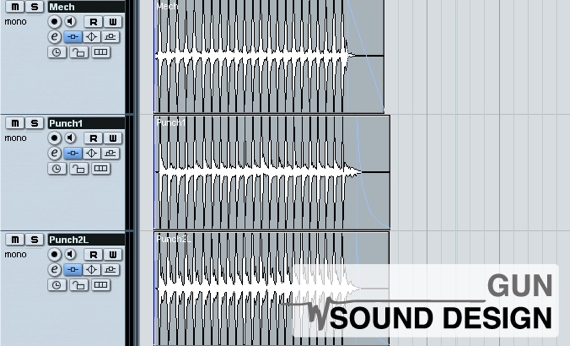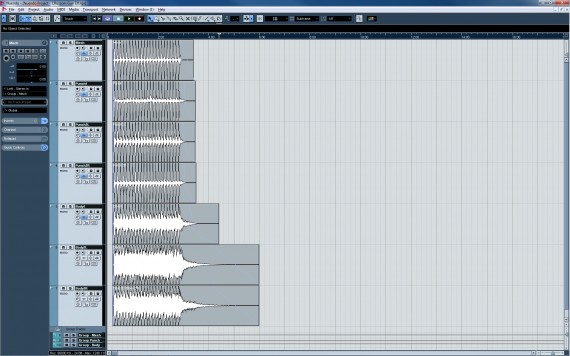I work on a lot of games that are filled with guns. Over the years, through experimentation, screwing up, listening to movies/games with great guns sounds, and tips from other sounds designers, I’ve been able to create a process that works well for me. The biggest influence on my gun sound design has not come in the studio, but on the gun range. I’ve shot a lot of guns. I’ve also been around a lot of guns while they were being fired. Hands-on education is really the best way to learn something. So, if you really want to improve your gun sound design, find a way to get out on a range where you can fire some guns off. The feel of a gun’s shockwave through your body as you fire it, the sore shoulder you have the day after shooting, the payoff of destroying a watermelon with a blast from a shotgun, these are some of the lasting lessons that you will learn.
I have a few philosophies/guidelines I try to follow when designing gun sounds for a game:
- Guns are loud. Try to reinforce that in your sound design
- Guns give the player feedback. The player is expecting a payoff when they fire a gun. Your gun sounds need to give the player a sense of satisfaction and make them want to fire the gun over and over again. Gun sounds need to make the player feel like a badass
- The player’s guns need to be the coolest sounding guns in the game
- The AI/Non Player gun sounds should not overtake the player’s. But, they still need to be scary and create stress/tension. Being shot at should not be a relaxing experience
- Bullet shell ejects and gun Foley (reloads, movement, etc) are very important to the sound and help the gun feel more real
- Every gun in the game needs a unique sound. You may have 20-30 different guns in a game. In reality, after a while all guns start to sound the same. Find a way to give each gun its own signature.
- Don’t forget the gun tail/decay. The first few hundred milliseconds of a gunshot have very little character. If you neglect the gun tail, your guns will sound less powerful and they will all sound very similar
Here is a little insight into my gun design process:
- I try to start from sounds of the actual gun if I can. If I can’t find source for a particular gun, I do some research and try to find a gun of the same caliber, with a similar rate of fire, that uses a similar mechanism. For handguns, I rarely start with handgun source. Handguns just don’t excite me; they are usually a lot weaker sounding than the “hand-cannons” that most people expect to hear. Watch the Indiana Jones films, his gun sound is not from a handgun, and it makes him seem really bad-ass when he fires it. When designing sounds for a project that is not based in reality, all bets are off. I just try to create cool sounds that fit the project and worry less about things like weapon caliber.
- Sounds of the bolt/action/mechanism are a very important component to a gun sound. Action sounds make the gun feel like it is a working piece of machinery. These sounds make the gun feel real. Even if they are real low in the mix, you can feel when they are not there.
- I stick to three basic layers when designing guns. Each layer is made up of the minimum amount of tracks that I can get away with. Less is always more. I call my layers: Mech (gun action/mechanism), Body (this best represents the full range of the gun. If I was going to use only one layer, this would be the one), and Punch (this is a bass/boom layer). If needed I will add additional sweeteners, like a layer to give more reverb/space, more bite, or whatever might be missing
- By designing in layers, I can create quick and easy remixes and alt mixes of a sound
- I’ve found the following processes/plugins useful at one time or another: EQ (usually cutting vs boosting), Compression, Limiting, Clippers/Transient processors (Oxford Transmod, Waves Trans X, T-Tracks Clipper), Saturation (Analog Channel, URS Saturator, etc), Bass Enhancers (Waves Ren Bass, Maxx Bass, and Lo Air), and I’ll sometimes use gain to clip the sound. Basically, I just make everything as loud as fuck
- I whipped up a quick sample of a machine gun burst. Below is screenshot of my Nuendo session that shows the layers I used. In this case, my Mech Layer was made up of one track. My Punch and Body layers were each made up of 3 tracks (really it is only two tracks, one mono track and spilt stereo (L/R) tracks). I edit each track and insert plugins as needed. The tracks in each layer are then balanced against each other and sent to a group. I use the groups to easily mix all the layers together, and create remixes or alt mixes, if needed.
Here are the sounds:
Mech Layer:
Punch Layer:
Body Layer:
Mix of all layers:


Great tips. Glad to see another Nuendo user.
Dave
A lovely read. Thanks again Chuck for sharing your years of experience.
Awesome, thanks! Very generous of you to share your experience.
Clear and simple, really great tips.
thanks for sharing.
Excellent advice.
Thanks for sharing it with us all.
Great article. I am going to be doing my first field recording with guns soon and this will help a lot. I really like how the Mech layer sounds too.
What a great gun sound. I know this is two years old, but I wonder:
The body layer seems to be an actual recording, but where do you get the mech sound from, and how to get a great punch like that? Is it from a cpmpletely different sound? The mech sound actually sounds as if a gun is shot without a bullet. Well it’s not possible…any suggestions? I’m a bloody beginner.
anyone know any materials that i can use to create gun sounds, without actually recording guns?
firecrackers, balloons anything else?
cheers
For a musical about the siege of the city of Groningen in 1672 I was commissioned to write the songs and underscores. But I somehow got also involved in the sound design.
That meant a lot of cannon and gun sounds + impacts. I tried real recordings, recordings of others but it all just didn’t cut it!
So I ended up to recreate the sounds with a synthesizer. It ended up fantastically!! I could stack the different modeled sounds: the extreme low boom, the fuse (when necessary), the igniting gun powder and the different colliding iron parts of the gun/cannon etcetera.
The main benefit of using this technique is that I could easily build in variations too by gently but effectively using a LFO modifier. And I could do this on ALL the different sounds!
I modeled the sounds with taking in consideration the exact chemical process in mind of a fast burning mixture of chemicals (sulfur, charcoal and potassic nitrate). Recreating the sound as precise as possible and thus NOT relying on samples and field recordings.
So the variation was enormous. No shot or impact sounded the same. The shots sound extremely brutal in the big theater AND to top it of: all these sounds where invoked by a midi keyboard to my laptop! Making it very interactive too. The audience loved it and shared their experience with me a lot of times saying things like: man, this was just like watching a great action movie instead of a musical!
When I saw your post it reminded me of this and I thought of sharing this too.
Thank you that you shared your awesome insights to all of us too!!